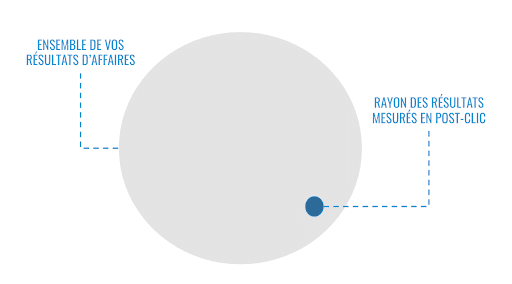Contributor
Will click-based attribution models soon be obsolete?
Contributor
In the most recent special edition of the scientific journal Applied Marketing Analytics (AMA), I published a peer-reviewed article entitled “Moving towards inferential attribution modelling in a world without third-party cookies.” The article suggested that marketing data experts should consider a gradual shift towards statistical inference in order to continue tracking the performance of their ad campaigns after the cookie apocalypse.
As you know third-party cookies will disappear from Chrome by 2023. As far as Apple goes, third-party cookies and mobile tracking known as Identifiers for Advertisers (IDFA) are already ancient history. As a result, measuring the effectiveness of your Facebook Ads or Google Ads campaigns directly on these platforms has increasingly become an issue. At the same time, a portion of these data are no longer stable within Google and Adobe Analytics, since the break-up of the measurement ecosystem, largely caused by Apple, has also affected the quality of first-party cookies.
There is only one simple, inevitable conclusion to be made from this: Performance measurement relying on clicks by users is about to disappear. As a result we will need to resort to performance measurement methods that digital marketers have been a bit snobby about for a long time, namely good old statistical inference analyses. This conclusion is supported by Julian Runge and Eric Seufert, amongst others, in the Harvard Business Review. In their article “Apple Is Changing How Digital Ads Work. Are Advertisers Prepared?” Runge and Seufert explain:
More traditional measurement solutions that are privacy-safe by default will likely stand to gain in relevance. For example, marketing mix models (MMMs) were developed on and for aggregate advertising and sales data observed over time and do not require any linking of lower-level tracking data.
In my recent AMA article, this is exactly what I tried to demonstrate, but by explaining that aggregated marketing data were today a lot richer and more voluminous than in the pre-digital era of traditional media. For example, a statistical analysis of a TV campaign is based on a lot fewer data than for a Facebook or Google campaign. In digital, even without access to the user’s private data, you can gather a lot of aggregated information about your users. Here are just a few examples:
- Aggregated geography
- Format of creative
- Aggregated audience segment
- Ad message
- Aggregated clicks and impressions
- Aggregated click-through rate
- Aggregated conversion rate
…and many more!
Furthermore, statistical inference techniques have themselves evolved a lot over the course of the last decade, especially with the emergence of data science. In that same article for Applied Marketing Analytics, I explore a few examples of these new inference techniques.
Ultimately, you need to keep in mind that the goal of click-based models is the same as for inference models, which is to improve the measurement of the effects of your marketing campaigns, whether you’re doing that through aggregated data or otherwise.
On the other hand, a major advantage of this shift towards inference attribution models is that they offer the possibility of measuring the effects of your marketing on all of your business results instead of isolating only the click and conversion method on a one-to-one basis (one click for one user). If your company is able to find the right model to combine your business data with your marketing campaign data, the potential impact on your overall performance can be tremendous.
Basically, the current range when measuring click-based attribution models is very limited. It isn’t possible to know the effects of your ad campaigns on your business results beyond the click measured. But it is possible to arrive at this answer with a high degree of statistical certainty using an inferential attribution model.
The question you should ask yourself is the following: What percentage of your overall results can be attributable to your marketing efforts? This is what a statistical inference model can be used to answer. To help you put things in perspective, the chart below illustrates the difference between the measurement range of a single click and the overall measurement of your company’s results during a marketing campaign.

However, the disadvantage of inferential models is that they increase the complexity of your company’s marketing analytics practice. As Runge and Seufert emphasize in the article mentioned above:
This approach requires sophisticated data-science expertise, and these types of models can be difficult to tune properly, but a measurement solution that relies on statistical sophistication is more robust and durable than one that relies on the precision of user identity.
In conclusion, would I say that click-based attribution with user data is a thing of the past? No. At least not in the short or medium term. But shrewd marketers should start to get used to the idea that it will no longer be possible to think solely in the granular analytical terms of customer clicks. You need to shift towards a hybrid mode combining clicks and inference. Both models can work very well together in a complementary way.
At the same time, you also need to think bigger, meaning thinking in terms of causal marketing with regard to the effects on your overall business results, and not solely in terms of insular campaign clicks. What’s more, returning to statistical models is a great opportunity to fully integrate performance measurement into all your media channels, both digital and traditional. In other words, it’s time for digital marketers to start thinking like 360 media marketers.
If you’re interested in learning what techniques are available to start developing your own inferential attribution model, I invite you to download my article free of charge, courtesy of Applied Marketing Analytics.
This article was first published in Applied Marketing Analytics Vol. 7 No. 1 and is reproduced with the permission of the publisher Henry Stewart Publications LLP, London, UK. For more details of Journal of Risk Management in Financial Institutions go to: https://www.henrystewartpublications.com/ama
Happy reading!




